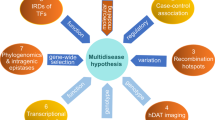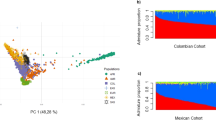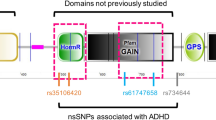Abstract
Studies provide ample evidence for a dysfunction in dopaminergic neurotransmission in Attention-Deficit/Hyperactivity Disorder (ADHD). In that respect, a common variable number of tandem repeats (VNTR) polymorphism in the 3′ untranslated region (UTR) of the dopamine transporter gene (SLC6A3) has been repeatedly associated with the disorder. Here, we examined the influence of the common 9- and 10-repeat alleles of SLC6A3 on prefrontal brain functioning and cognitive response control in a large sample of adult ADHD patients (n=161) and healthy controls (n=109). To this end, we inspected a neurophysiological marker of cognitive response control (NoGo anteriorization, NGA) elicited by means of a Go-NoGo task (continuous performance test, CPT). Within the group of ADHD patients, nine-repeat allele carriers showed significantly reduced NGA, whereas no influence of SLC6A3 genotype was observed in the control group. In contrast to previous association studies of children, the nine-repeat—not the 10-repeat—allele was associated with functional impairments in our sample of adult ADHD patients. Our findings confirm a significant effect of the SLC6A3 genotype on the neurophysiological correlates of cognitive response control in ADHD, and indicate that still to-be-identified age-related factors are important variables modulating the effect of genetic factors on endophenotypes.
Similar content being viewed by others
Log in or create a free account to read this content
Gain free access to this article, as well as selected content from this journal and more on nature.com
or
References
Almasy L, Blangero J (2001). Endophenotypes as quantitative risk factors for psychiatric disease: rationale and study design. Am J Med Genet 105: 42–44.
Baehne CG, Ehlis AC, Plichta MM, Conzelmann A, Pauli P, Jacob C et al (2009). Tph2 gene variants modulate response control processes in adult ADHD patients and healthy individuals. Mol Psychiatry 14: 1032–1039.
Barkley RA (1997). Behavioral inhibition, sustained attention, and executive functions: constructing a unifying theory of ADHD. Psychol Bull 121: 65–94.
Barkley RA (1998). Attention-Deficit Hyperactivity Disorder: a Handbook for Diagnosis and Treatment, 2nd edn. Guilford: New York.
Barkley RA, Smith KM, Fischer M, Navia B (2006). An examination of the behavioral and neuropsychological correlates of three ADHD candidate gene polymorphisms (DRD4 7+, DBH TaqI A2, and DAT1 40 bp VNTR) in hyperactive and normal children followed to adulthood. Am J Med Genet B Neuropsychiatr Genet 141: 487–498.
Bellgrove MA, Hawi Z, Kirley A, Gill M, Robertson IH (2005). Dissecting the attention deficit hyperactivity disorder (ADHD) phenotype: sustained attention, response variability and spatial attentional asymmetries in relation to dopamine transporter (DAT1) genotype. Neuropsychologia 43: 1847–1857.
Bertolino A, Blasi G, Latorre V, Rubino V, Rampino A, Sinibaldi L et al (2006). Additive effects of genetic variation in dopamine regulating genes on working memory cortical activity in human brain. J Neurosci 26: 3918–3922.
Biederman J (2005). Attention-deficit/hyperactivity disorder: a selective overview. Biol Psychiatry 57: 1215–1220.
Biederman J, Faraone SV (2005). Attention-deficit hyperactivity disorder. Lancet 366: 237–248.
Bookheimer SY, Strojwas MH, Cohen MS, Saunders AM, Pericak-Vance MA, Mazziotta JC et al (2000). Patterns of brain activation in people at risk for Alzheimer's disease. N Engl J Med 343: 450–456.
Chen CK, Chen SL, Mill J, Huang YS, Lin SK, Curran S et al (2003). The dopamine transporter gene is associated with attention deficit hyperactivity disorder in a Taiwanese sample. Mol Psychiatry 8: 393–396.
Cheuk DK, Li SY, Wong V (2006). No association between VNTR polymorphisms of dopamine transporter gene and attention deficit hyperactivity disorder in Chinese children. Am J Med Genet B Neuropsychiatr Genet 141: 123–125.
Cook Jr EH, Stein MA, Krasowski MD, Cox NJ, Olkon DM, Kieffer JE et al (1995). Association of attention-deficit disorder and the dopamine transporter gene. Am J Hum Genet 56: 993–998.
Crosbie J, Perusse D, Barr CL, Schachar RJ (2008). Validating psychiatric endophenotypes: inhibitory control and attention deficit hyperactivity disorder. Neurosci Biobehav Rev 32: 40–55.
Curran S, Mill J, Tahir E, Kent L, Richards S, Gould A et al (2001). Association study of a dopamine transporter polymorphism and attention deficit hyperactivity disorder in UK and Turkish samples. Mol Psychiatry 6: 425–428.
Egan MF, Goldberg TE, Kolachana BS, Callicott JH, Mazzanti CM, Straub RE et al (2001). Effect of COMT Val108/158 Met genotype on frontal lobe function and risk for schizophrenia. Proc Natl Acad Sci USA 98: 6917–6922.
Ehlis AC, Reif A, Herrmann MJ, Lesch KP, Fallgatter AJ (2007). Impact of catechol-O-methyltransferase on prefrontal brain functioning in schizophrenia spectrum disorders. Neuropsychopharmacology 32: 162–170.
Epstein JN, Conners CK, Sitarenios G, Erhardt D (1998). Continuous performance test results of adults with attention deficit hyperactivity disorder. Clin Neuropsychol 12: 155–168.
Fallgatter AJ, Brandeis D, Strik WK (1997). A robust assessment of the NoGo-anteriorisation of P300 microstates in a cued Continuous Performance Test. Brain Topogr 9: 295–302.
Fallgatter AJ, Ehlis AC, Rosler M, Strik WK, Blocher D, Herrmann MJ (2005). Diminished prefrontal brain function in adults with psychopathology in childhood related to attention deficit hyperactivity disorder. Psychiatry Res 138: 157–169.
Fallgatter AJ, Ehlis AC, Seifert J, Strik WK, Scheuerpflug P, Zillessen KE et al (2004). Altered response control and anterior cingulate function in attention-deficit/hyperactivity disorder boys. Clin Neurophysiol 115: 973–981.
Fallgatter AJ, Jatzke S, Bartsch AJ, Hamelbeck B, Lesch KP (1999a). Serotonin transporter promoter polymorphism influences topography of inhibitory motor control. Int J Neuropsychopharmacol 2: 115–120.
Fallgatter AJ, Mueller TJ, Strik WK (1999b). Age-related changes in the brain electrical correlates of response control. Clin Neurophysiol 110: 833–838.
Fallgatter AJ, Strik WK (1999). The NoGo-anteriorization as a neurophysiological standard-index for cognitive response control. Int J Psychophysiol 32: 233–238.
Faraone SV, Doyle AE (2000). Genetic influences on attention deficit hyperactivity disorder. Curr Psychiatry Rep 2: 143–146.
Faraone SV, Perlis RH, Doyle AE, Smoller JW, Goralnick JJ, Holmgren MA et al (2005). Molecular genetics of attention-deficit/hyperactivity disorder. Biol Psychiatry 57: 1313–1323.
Franke B, Arias Vasquez A, Johansson S, Hoogman M, Romanos J, Boreatti-Hümmer A et al (2010). Meta-analysis of the SLC6A3/DAT1 VNTR haplotype in adult ADHD suggests differential involvement of the gene in adult and childhood ADHD. Neuropsychopharmacoly 35: 656–664.
Franke B, Hoogman M, Arias Vasquez A, Heister JG, Savelkoul PJ, Naber M et al (2008). Association of the dopamine transporter (SLC6A3/DAT1) gene 9-6 haplotype with adult ADHD. Am J Med Genet B Neuropsychiatr Genet 147: 1576–1579.
Fuke S, Suo S, Takahashi N, Koike H, Sasagawa N, Ishiura S (2001). The VNTR polymorphism of the human dopamine transporter (DAT1) gene affects gene expression. Pharmacogenomics J 1: 152–156.
Gratton G, Coles MGH (1989). Generalization and evaluation of eye-movement correction procedures. J Psychophysiol 3: 1–50.
Greenwood TA, Kelsoe JR (2003). Promoter and intronic variants affect the transcriptional regulation of the human dopamine transporter gene. Genomics 82: 511–520.
Heinz A, Goldman D, Jones DW, Palmour R, Hommer D, Gorey JG et al (2000). Genotype influences in vivo dopamine transporter availability in human striatum. Neuropsychopharmacology 22: 133–139.
Hünnerkopf R, Strobel A, Gutknecht L, Brocke B, Lesch KP (2007). Interaction between BDNF Val66Met and dopamine transporter gene variation influences anxiety-related traits. Neuropsychopharmacology 32: 2552–2560.
Jasper H (1958). Report of committee on methods of clinical exam in EEG. Electroencephalogr Clin Neurophysiol 10: 370–375.
Kessler RC, Adler L, Barkley R, Biederman J, Conners CK, Demler O et al (2006). The prevalence and correlates of adult ADHD in the United States: results from the National Comorbidity Survey Replication. Am J Psychiatry 163: 716–723.
Krause KH, Dresel SH, Krause J, Kung HF, Tatsch K (2000). Increased striatal dopamine transporter in adult patients with attention deficit hyperactivity disorder: effects of methylphenidate as measured by single photon emission computed tomography. Neurosci Lett 285: 107–110.
Langley K, Turic D, Peirce TR, Mills S, Van Den Bree MB, Owen MJ et al (2005). No support for association between the dopamine transporter (DAT1) gene and ADHD. Am J Med Genet B Neuropsychiatr Genet 139: 7–10.
Lehmann D (1987). Principles of spatial analysis. In: Gevins A, Remond A (eds). Handbook of Electroencephalography and Clinical Neurophysiology, Vol. 1: Methods of Analysis of Brain Electrical and Magnetic Signals. Elsevier: Amsterdam. pp 309–354.
Lehrl S (2005). Mehrfachwahl-Wortschatz-Intelligenztest MWT-B. Spitta Verlag: Balingen.
Leth-Steensen C, Elbaz ZK, Douglas VI (2000). Mean response times, variability, and skew in the responding of ADHD children: a response time distributional approach. Acta Psychol (Amst) 104: 167–190.
Levy F, Hay DA, McStephen M, Wood C, Waldman I (1997). Attention-deficit hyperactivity disorder: a category or a continuum? Genetic analysis of a large-scale twin study. J Am Acad Child Adolesc Psychiatry 36: 737–744.
Lewis DA, Melchitzky DS, Sesack SR, Whitehead RE, Auh S, Sampson A (2001). Dopamine transporter immunoreactivity in monkey cerebral cortex: regional, laminar, and ultrastructural localization. J Comp Neurol 432: 119–136.
Li D, Sham PC, Owen MJ, He L (2006). Meta-analysis shows significant association between dopamine system genes and attention deficit hyperactivity disorder (ADHD). Hum Mol Genet 15: 2276–2284.
Loo SK, Specter E, Smolen A, Hopfer C, Teale PD, Reite ML (2003). Functional effects of the DAT1 polymorphism on EEG measures in ADHD. J Am Acad Child Adolesc Psychiatry 42: 986–993.
Losier BJ, McGrath PJ, Klein RM (1996). Error patterns on the continuous performance test in non-medicated and medicated samples of children with and without ADHD: a meta-analytic review. J Child Psychol Psychiatry 37: 971–987.
Martin N, Scourfield J, McGuffin P (2002). Observer effects and heritability of childhood attention-deficit hyperactivity disorder symptoms. Br J Psychiatry 180: 260–265.
Martinez D, Gelernter J, Abi-Dargham A, van Dyck CH, Kegeles L, Innis RB et al (2001). The variable number of tandem repeats polymorphism of the dopamine transporter gene is not associated with significant change in dopamine transporter phenotype in humans. Neuropsychopharmacology 24: 553–560.
Michelhaugh SK, Fiskerstrand C, Lovejoy E, Bannon MJ, Quinn JP (2001). The dopamine transporter gene (SLC6A3) variable number of tandem repeats domain enhances transcription in dopamine neurons. J Neurochem 79: 1033–1038.
Mill J, Asherson P, Browes C, D’Souza U, Craig I (2002). Expression of the dopamine transporter gene is regulated by the 3′ UTR VNTR: evidence from brain and lymphocytes using quantitative RT-PCR. Am J Med Genet 114: 975–979.
Miller GM, Madras BK (2002). Polymorphisms in the 3′-untranslated region of human and monkey dopamine transporter genes affect reporter gene expression. Mol Psychiatry 7: 44–55.
Newman J, Grace AA (1999). Binding across time: the selective gating of frontal and hippocampal systems modulating working memory and attentional states. Conscious Cogn 8: 196–212.
Pascal-Marqui RD, Michel CM, Lehmann D (1994). Low resolution electromagnetic tomography: a new method for localizing electrical activity in the brain. Int J Psychophysiol 18: 49–65.
Pascual-Marqui RD (2002). Standardized low-resolution brain electromagnetic tomography (sLORETA): technical details. Method Find Exp Clin Pharmacol 24: 5–12.
Pascual-Marqui RD, Esslen M, Kochi K, Lehmann D (2002). Functional imaging with low resolution brain electromagnetic tomography (LORETA): a review. Method Find Exp Clin 24: 91–95.
Retz-Junginger P, Retz W, Blocher D, Weijers HG, Trott GE, Wender PH et al (2002). [Wender Utah rating scale. The short-version for the assessment of the attention-deficit hyperactivity disorder in adults]. Nervenarzt 73: 830–838.
Rosvold HE, Mirsky A, Sarason I, Bransome ED, Beck LH (1956). A continuous performance test of brain damage. J Consult Psychol 20: 343–350.
Rubia K, Overmeyer S, Taylor E, Brammer M, Williams SC, Simmons A et al (1999). Hypofrontality in attention deficit hyperactivity disorder during higher-order motor control: a study with functional MRI. Am J Psychiatry 156: 891–896.
Sesack SR, Hawrylak VA, Matus C, Guido MA, Levey AI (1998). Dopamine axon varicosities in the prelimbic division of the rat prefrontal cortex exhibit sparse immunoreactivity for the dopamine transporter. J Neurosci 18: 2697–2708.
Simon V, Czobor P, Balint S, Meszaros A, Bitter I (2009). Prevalence and correlates of adult attention-deficit hyperactivity disorder: meta-analysis. Br J Psychiatry 194: 204–211.
Slaats-Willemse D (2003). Cognitive Endophenotypes of ADHD. Ponsen & Looijen BV: Wageningen.
Smith AB, Taylor E, Brammer M, Toone B, Rubia K (2006). Task-specific hypoactivation in prefrontal and temporoparietal brain regions during motor inhibition and task switching in medication-naive children and adolescents with attention deficit hyperactivity disorder. Am J Psychiatry 163: 1044–1051.
Sonuga-Barke EJ (2002). Psychological heterogeneity in AD/HD--a dual pathway model of behaviour and cognition. Behav Brain Res 130: 29–36.
Spencer TJ, Biederman J, Madras BK, Dougherty DD, Bonab AA, Livni E et al (2007). Further evidence of dopamine transporter dysregulation in ADHD: a controlled PET imaging study using altropane. Biol Psychiatry 62: 1059–1061.
Spencer TJ, Biederman J, Madras BK, Faraone SV, Dougherty DD, Bonab AA et al (2005). In vivo neuroreceptor imaging in attention-deficit/hyperactivity disorder: a focus on the dopamine transporter. Biol Psychiatry 57: 1293–1300.
Todd RD, Huang H, Smalley SL, Nelson SF, Willcutt EG, Pennington BF et al (2005). Collaborative analysis of DRD4 and DAT genotypes in population-defined ADHD subtypes. J Child Psychol Psychiatry 46: 1067–1073.
van de Giessen EM, de Win MM, Tanck MW, van den Brink W, Baas F, Booij J (2009). Striatal dopamine transporter availability associated with polymorphisms in the dopamine transporter gene SLC6A3. J Nucl Med 50: 45–52.
van Dyck CH, Malison RT, Jacobsen LK, Seibyl JP, Staley JK, Laruelle M et al (2005). Increased dopamine transporter availability associated with the 9-repeat allele of the SLC6A3 gene. J Nucl Med 46: 745–751.
Vandenbergh DJ, Persico AM, Uhl GR (1992). A human dopamine transporter cDNA predicts reduced glycosylation, displays a novel repetitive element and provides racially-dimorphic TaqI RFLPs. Brain Res Mol Brain Res 15: 161–166.
VanNess SH, Owens MJ, Kilts CD (2005). The variable number of tandem repeats element in DAT1 regulates in vitro dopamine transporter density. BMC Genetics 6: 55.
Winsberg BG, Comings DE (1999). Association of the dopamine transporter gene (DAT1) with poor methylphenidate response. J Am Acad Child Adolesc Psychiatry 38: 1474–1477.
Wittchen H-U, Wunderlich U, Gruschwitz S, Zaudig M (1997). SKID-I. Strukturiertes Klinisches Interview für DSM-IV. Achse I: Psychische Störungen [SCID-I. Structured Clinical Interview for DSM-IV, Axis I—Disorders]. Göttingen: Hogrefe.
Yang B, Chan RC, Jing J, Li T, Sham P, Chen RY (2007). A meta-analysis of association studies between the 10-repeat allele of a VNTR polymorphism in the 3′-UTR of dopamine transporter gene and attention deficit hyperactivity disorder. Am J Med Genet B Neuropsychiatr Genet 144: 541–550.
Acknowledgements
This study was supported by the Deutsche Forschungsgemeinschaft (KFO 125, SFB TRR 58 C4) and the Bundesministerium für Bildung und Forschung (BMBF 01GV0605).
Author information
Authors and Affiliations
Corresponding author
Ethics declarations
Competing interests
The authors declare no conflict of interest.
Rights and permissions
About this article
Cite this article
Dresler, T., Ehlis, AC., Heinzel, S. et al. Dopamine Transporter (SLC6A3) Genotype Impacts Neurophysiological Correlates of Cognitive Response Control in an Adult Sample of Patients with ADHD. Neuropsychopharmacol 35, 2193–2202 (2010). https://doi.org/10.1038/npp.2010.91
Received:
Revised:
Accepted:
Published:
Issue date:
DOI: https://doi.org/10.1038/npp.2010.91
Keywords
This article is cited by
-
Electrophysiological underpinnings of dysfunctional inhibitory control in adults with attention-deficit/hyperactivity disorder: evidence for reduced NoGo anteriorization
Journal of Neural Transmission (2023)
-
Genetic and molecular biology of autism spectrum disorder among Middle East population: a review
Human Genomics (2021)
-
Association study and a systematic meta-analysis of the VNTR polymorphism in the 3′-UTR of dopamine transporter gene and attention-deficit hyperactivity disorder
Journal of Neural Transmission (2019)
-
Occipital event-related potentials to addiction-related stimuli in detoxified patients with alcohol dependence, and their association with three-month relapse
BMC Psychiatry (2016)
-
Attention-deficit hyperactivity disorder in adults: A systematic review and meta-analysis of genetic, pharmacogenetic and biochemical studies
Molecular Psychiatry (2016)



